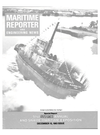
Page 29: of Maritime Reporter Magazine (December 15, 1983)
Read this page in Pdf, Flash or Html5 edition of December 15, 1983 Maritime Reporter Magazine
tion in Belfast, and the marketing worldwide of the Friendship HT type dry cargo vessel designed by the international firm of naval ar- chitects G.T.R. Campbell of the
Bahamas. It is believed to be the first time that such an agreement has been signed between a North
European shipbuilder and a Japa- nese shipbuilder.
The Friendship series of vessels are designed to cope with the sub- stantial increases in fuel costs and associated operational factors in- cluding changes in the variety of cargoes which medium sized mul- tipurpose cargo vessels are being called upon to carry in the present economic climate. The versatility of the series makes it possible to switch easily from general cargoes to containers and to maintain ship administration efficiency onboard.
On the technical side, details of the existing design now held by
I.H.I, will be provided to the Bel- fast yard, and future refinements and developments of the design will be available to both compa- nies who will maintain close liai- son to ensure that all vessels built under the agreement will each contain the same commercially ad- vantageous performance charac- teristics and high standards of construction that have created the current market for the Friendship series vessels in both shipbuilding locations. The agreement also pro- vides for regular interchange of personnel between the parties whereby the maximum benefits are obtained from this unique co- operation between two of the world's major shipbuilders.
On the marketing side, Harland and Wolff Limited have been granted exclusive rights to build in the U.K. and rights to offer the vessel on the world market.
Nautilus Unveils New Crane
With 40-Ton Lift Capacity —Literature Available
Fred Oprendek, president of
Nautilus Crane & Equipment Cor- poration, has announced the avail- ability of a new crane with lifting capacities of up to 80,000 pounds.
Designated the 180L, the new crane is of lattice boom construction with an overturning moment design of 1,800,000 foot-pounds, and is de- signed to replace and standardize existing offshore equipment.
The 180L was designed by Earl
Bares, chief engineer at Nautilus, to give offshore platforms, dock op- erators, and service vessels a mod- ularly designed crane with good capacity and ease of maintenance.
Features of the 180L include: 20-inch-diameter sheaves that are removable without disturbing pen- dant and line components; inter- changeable gantries; right or left cab and/or power; easily accessible grease points; and optional cen- tralized lube system.
For more information and free literature on the 180L and other
Nautilus cranes,
Write 76 on Reader Service Card
Write 340 on Reader Service Card
Maritime Protection Unveils
New Nitrogen Generator—
Literature Available
Maritime Protection A/S of
Kristiansand, Norway, recently introduced a new nitrogen gener- ator for marine use. The unit is said to be particularly suited for ships in the chemical and gas trades, drilling rigs, and barges, and will be a convenient alterna- tive to nitrogen bottles. The gen- erator has no moving parts, is vir- tually maintenance-free, and light in weight.
The heart of the system is the technology of membrane gas sepa- ration designed and developed by the U.S.-based Monsanto Com- pany. Prism separators made by
Monsanto have gained wide ac- ceptance in the chemical and pe- troleum industries, with 40 plants installed or on order since 1977.
The generators produce an inert atmosphere by removing oxygen from air. They have sizes pres- ently ranging from 100 to 500 cu- bic meters per hour of high-purity nitrogen (95-99 percent pure) with a dew point of minus 70 C.
For more information and free literature on the new nitrogen generator,
Write 86 on Reader Service Card
NOW THE WATCH OFFICER
HAS A LOT LESS TO WATCH...
BECAUSE SPERRY KNOWS HOW TO LISTEN.
For the first time, every essential element needed by the watch officer for total ship course control is centered in one console—the Sperry SRP-2000 Ship Control
System. Information formerly obtained from annuncia- tors, remote indicators and communication relays is now displayed at this one control center using Sperry's advanced design concepts and digital microprocessor technology.
The SRP-2000 is an integral adaptive autopilot giving unparalleled fuel savings through precise monitoring of sea conditions by continually adjusting system gain settings for optimal steering.
In automatic navigation mode, the SRP-2000 provides route planning and automatic route tracking, based on
SATNAV, LORAN, or manual fix inputs. These functions improve fuel efficiency by minimizing route distance.
As a ship control center, it displays real-time alpha- numeric readout of all navigation data and steering system conditions, at the touch of a button.
To free the watch officer for his command function, there is a fingertip call-up of step-by-step operating proce- dures for all normal, emergency and troubleshooting conditions.
The Sperry SRP-2000 Ship Control System provides the ultimate in fuel efficiency, functional information display and simplicity of control, without extra modules or add-ons.
Want to know more about how Sperry can help you obtain substantial fuel savings and peak performance from your watch crew? Talk to us.. .we listen.
Write to Sperry Corporation, Electronic Systems, Great
Neck, NY 11020. Attention: Marketing Department.
T w' 4 \ I a c SPERRY CORPORATION 1983

 28
28

 30
30
